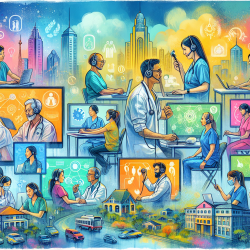Introduction
In the realm of healthcare education, the necessity to bridge curriculum gaps is ever-present, especially when addressing socioeconomic determinants of health. The study titled "IMAGINE-ing Interprofessional Education: Program Evaluation of a Novel Inner City Health Educational Experience" provides a compelling case for the integration of interprofessional education (IPE) in healthcare curricula. This blog explores the key findings of this study and how practitioners can leverage these insights to improve their skills and outcomes for underserved populations.
Understanding the Study
The study evaluated a student-run interprofessional inner city health educational program designed to address the curriculum gap in poverty intervention. The program aimed to enhance students' knowledge and comfort in working with underserved populations by combining practical experiences with didactic learning. Participants included students from various healthcare disciplines, including medicine, nursing, pharmacy, social work, and speech-language pathology.
Key Findings
- Increased Knowledge: Students reported significant increases in knowledge about issues facing underserved populations and resources available to them.
- Enhanced Comfort: Participants felt more comfortable working with underserved populations after the program.
- Valued Components: Workshops, shadowing experiences, and interprofessional discussions were highly valued by participants.
Implications for Practitioners
Practitioners can draw several lessons from this study to enhance their skills and improve outcomes for children and other vulnerable populations:
- Embrace Interprofessional Collaboration: Engaging with professionals from various disciplines can provide a more holistic approach to patient care, especially for complex cases involving socioeconomic factors.
- Focus on Practical Tools: Incorporating practical tools and strategies for poverty intervention can enhance the effectiveness of therapy and support services.
- Continual Learning: Staying informed about the latest research and integrating new insights into practice can lead to better outcomes for underserved populations.
Encouraging Further Research
While the study provides valuable insights, it also highlights the need for further research into long-term outcomes of interprofessional education programs. Practitioners are encouraged to engage in ongoing research and evaluation to continually improve their practice and address emerging challenges in healthcare.
Conclusion
Interprofessional education represents a promising strategy to enhance healthcare practitioners' skills and improve outcomes for underserved populations. By integrating these insights into online therapy services, such as those provided by TinyEYE, practitioners can better address the needs of children and other vulnerable groups. To read the original research paper, please follow this link: IMAGINE-ing interprofessional education: program evaluation of a novel inner city health educational experience.










